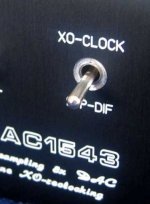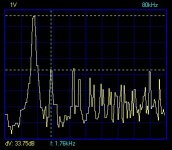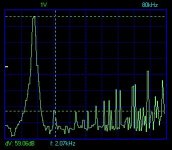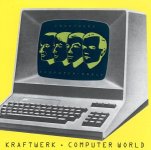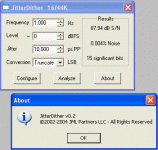Peter Daniel said:
I will try reclocking with TDA1541 as well. I just don't like it with the 1543 chip.
Maybe this will be part of your "correct implementation of the TDA1541"
Been a long while since I've contributed...
I tried reclocking 2x AD1861 using Elso's reclocker. Very impressive results. I wouldn't go back. Sound stage opened right up and the result was less harsh, with more audiable detail. This is ironic since asynchronous reclocking loses information. Obviously the audiable benefits outweigh the information losses.

Question-
Can anyone help with some advice on using silver-mica capacitors for my reclocker. currently I'm using NPO ceramic. My question is....
Will silver-mica produce better results, since these will obviously be more bulky and may have higher inductance, resulting in more impedance at high frequencies. These have to operate at 100Mhz where inductance becomes a serious issue!
Elso suggested the use of a polypropylene capacitor to couple the signal- is this appropriate at 100Mhz?
I tried reclocking 2x AD1861 using Elso's reclocker. Very impressive results. I wouldn't go back. Sound stage opened right up and the result was less harsh, with more audiable detail. This is ironic since asynchronous reclocking loses information. Obviously the audiable benefits outweigh the information losses.
Question-
Can anyone help with some advice on using silver-mica capacitors for my reclocker. currently I'm using NPO ceramic. My question is....
Will silver-mica produce better results, since these will obviously be more bulky and may have higher inductance, resulting in more impedance at high frequencies. These have to operate at 100Mhz where inductance becomes a serious issue!
Elso suggested the use of a polypropylene capacitor to couple the signal- is this appropriate at 100Mhz?
Asynchronous Reclocking
Hi Oli,
Your result confirms my idea that the ASR improves the sound with the Analog Devices DAC’s, R2R types. I did not want to miss it with the AD1865N-K. I don't have an explanation why the result with the TDA1543 is much less spectacular.
I don't think we loose information as long as we use two flip-flops in series. In this case there are no dropouts and scope pictures look AOK.
Silver mica caps work just as well as NPO ceramics but are much more expensive. I had more problems finding the right type of inductors. The "resistor" style inductor did not work well.
This a page picturing the type I am using:
http://217.34.228.137/Pages/MOLD/page84.htm
The 10nF polypropylene improved the sound a bit over a ceramic disc cap. I tried several types here. The frequency of my ASR is 60 -66 MHz, though a 100MHz crystal is used.

Hi Oli,
Your result confirms my idea that the ASR improves the sound with the Analog Devices DAC’s, R2R types. I did not want to miss it with the AD1865N-K. I don't have an explanation why the result with the TDA1543 is much less spectacular.
I don't think we loose information as long as we use two flip-flops in series. In this case there are no dropouts and scope pictures look AOK.
Silver mica caps work just as well as NPO ceramics but are much more expensive. I had more problems finding the right type of inductors. The "resistor" style inductor did not work well.
This a page picturing the type I am using:
http://217.34.228.137/Pages/MOLD/page84.htm
The 10nF polypropylene improved the sound a bit over a ceramic disc cap. I tried several types here. The frequency of my ASR is 60 -66 MHz, though a 100MHz crystal is used.
Hi,
Elso: I don't have an explanation why the result with the TDA1543 is much less spectacular.
Maybe because with AD1865 you are reclocking Latch enable, which triggers output conversion, so if you have low jitter Latch enable, you have low jitter analog output.
In case of TDA1543 you are reclocking word clock and bit clock, where one off this signal triggers analog output through some internal logic with its own additional jitter.
Have a nice day,
Borisov57
Elso: I don't have an explanation why the result with the TDA1543 is much less spectacular.
Maybe because with AD1865 you are reclocking Latch enable, which triggers output conversion, so if you have low jitter Latch enable, you have low jitter analog output.
In case of TDA1543 you are reclocking word clock and bit clock, where one off this signal triggers analog output through some internal logic with its own additional jitter.
Have a nice day,
Borisov57
The only true comparison is real A-B. Like I use in the dddac1543. Actually you can switch, whilst playing from normal clock to asynch reclocking mode. Everone, no exceptions, who I demonstrated this and also people who built the same design and did the test themselves were the same opinion. it works........ more space, more clear soundstage, no discussion needed, blind test, clearly detectable. No theorie, no datasheets, no different designs, no cable plugging, just click and there it is.....
BUT, it only works, if you use a XO clock which is 11.2896 Mhz. I tried 12, 18 and 24Mhz and it produces clearly noticable IM distortion......
regards,
doede
BUT, it only works, if you use a XO clock which is 11.2896 Mhz. I tried 12, 18 and 24Mhz and it produces clearly noticable IM distortion......
regards,
doede
Attachments
Hi Peter,
I used 12, 18 24 Mhz, VERY bad......
look at this pic..... shows a 1kHz sine wave spectrum reclocked with 12 Mhz. You can hear the xtra tones with female voices easily, brrrr
schematic is on my site at download.....
www.dddac.de
doede
I used 12, 18 24 Mhz, VERY bad......
look at this pic..... shows a 1kHz sine wave spectrum reclocked with 12 Mhz. You can hear the xtra tones with female voices easily, brrrr
schematic is on my site at download.....
www.dddac.de
doede
Attachments
Cheers for the info Elso!
I can't argue that asynchronous reclocking will lose data if you have performed measurements and found the waveform is preserved. Regardless, asynchronous reclocking sounds best to me!
My thought would be that any data/fsync/ws transitions that occur whilst clock transistions occur would give rise to metastable states- i.e the flip flops would latch up for an unspecified period of time and data would be lost during this time. I thought the second flip-flop simply maintained synchronicity. Once the first flip-flop unlatched from lock-up the timing could be re-established with this second flip-flop. I.e Data can be lost, but timing is preserved.
My prototype reclocker is built on Veroboard. I am doing a proper PCB for the whole DAC. In your view will silver-mica capacitors provide any sonic benefits over NPO ceramics? I may as well use the best component I can- my time is more precious.
What if I replace the aforementioned polypropylene capacitor with a silver-mica capacior too? This capacitor does sit in the clock path.
I can't argue that asynchronous reclocking will lose data if you have performed measurements and found the waveform is preserved. Regardless, asynchronous reclocking sounds best to me!
My thought would be that any data/fsync/ws transitions that occur whilst clock transistions occur would give rise to metastable states- i.e the flip flops would latch up for an unspecified period of time and data would be lost during this time. I thought the second flip-flop simply maintained synchronicity. Once the first flip-flop unlatched from lock-up the timing could be re-established with this second flip-flop. I.e Data can be lost, but timing is preserved.
My prototype reclocker is built on Veroboard. I am doing a proper PCB for the whole DAC. In your view will silver-mica capacitors provide any sonic benefits over NPO ceramics? I may as well use the best component I can- my time is more precious.
What if I replace the aforementioned polypropylene capacitor with a silver-mica capacior too? This capacitor does sit in the clock path.
Doede,dddac said:I used 12, 18 24 Mhz, VERY bad......
look at this pic..... shows a 1kHz sine wave spectrum reclocked with 12 Mhz. You can hear the xtra tones with female voices easily, brrrr
Reclocking with non Fs multiple frequencies won’t in itself introduce that distortion.
Pedja
Pedja said:
Doede,
Reclocking with non Fs multiple frequencies won’t in itself introduce that distortion.
Pedja
Given that you are effectively introducing correlated jitter, I would have thought an unpleasant tone would be very likely.
BTW isn't "By pressing down a special key it plays a little melody" from the track Pocket Calculator by Kraftwerk ?
None jitter we are talking here about could introduce that level of distortion.rfbrw said:Given that you are effectively introducing correlated jitter, I would have thought an unpleasant tone would be very likely.
Sure. You can try pressing the keys by yourself if you enter the site and then go two steps left.BTW isn't "By pressing down a special key it plays a little melody" from the track Pocket Calculator by Kraftwerk ?
http://www.kraftwerk.com/
Pedja
Attachments
Pedja said:
None jitter we are talking here about could introduce that level of distortion.
Pedja
I'd have to disagree with you on that. The negative effects of what amounts to modulating Fs would get worse as you lower the resampling frequency.
ray.
To evaluate the audibility of jitter and dither, I wrote this little program, jitterdither.zip. The included source code should answer any questions about what the programs does. Recompile it if you are wary of viruses in downloaded exe files. [/B][/QUOTE]
------------------------------------------------------------------------------
I am not clever enough to understand the source code but dis run jittertest thru' my spectrum analyser. What I got was a series of spaced hrmonics with a fundamental.
Can you please explain how this should be used to measure jitter?

------------------------------------------------------------------------------
I am not clever enough to understand the source code but dis run jittertest thru' my spectrum analyser. What I got was a series of spaced hrmonics with a fundamental.
Can you please explain how this should be used to measure jitter?
Interesting, but I have no idea what you were measuring. The program doesn’t output anything expect a few numbers. It samples a mathematically perfect sinusoid, using the specified parameters, and compares the result, sample by sample, to the original.fmak said:What I got was a series of spaced hrmonics with a fundamental.
-----------------------------------------------------------------------------Ulas said:
Interesting, but I have no idea what you were measuring. The program doesn’t output anything expect a few numbers. It samples a mathematically perfect sinusoid, using the specified parameters, and compares the result, sample by sample, to the original.
The jitter file is a wav file which when opened by a spectrum analyser gives me a near 0 dB pulse at high freq surrounded by discrete harmonic from lf to hf.
What should I have seen?
Re: wav file
Pedja
Can you pl explain how you got to this? I downloaded the Ulas jittertest file which is a wav file with a 12-13 kHz pulse with little pulses spread over the spectrum.
Have I done something else from what is intended?????
-----------------------------------------------------------------------------Pedja said:Funny.
Pedja
Can you pl explain how you got to this? I downloaded the Ulas jittertest file which is a wav file with a 12-13 kHz pulse with little pulses spread over the spectrum.
Have I done something else from what is intended?????
Fmak,
Two zip files by Ulas (ARCjitter.zip and ARCslip.zip) linked in this thread are zipped Excell spreadsheets and one zip file (jitterdither.zip) is the program consisting of 4 files (one executable, that is the one you see above). What is the file you are refereeing to?
Two zip files by Ulas (ARCjitter.zip and ARCslip.zip) linked in this thread are zipped Excell spreadsheets and one zip file (jitterdither.zip) is the program consisting of 4 files (one executable, that is the one you see above). What is the file you are refereeing to?
----------------------------------------------------------------------------Pedja said:Fmak,
Two zip files by Ulas (ARCjitter.zip and ARCslip.zip) linked in this thread are zipped Excell spreadsheets and one zip file (jitterdither.zip) is the program consisting of 4 files (one executable, that is the one you see above). What is the file you are refereeing to?
I am stupid; ran I file I downloaded called jittertest!! No idea how this works.
jitterdither.zip is no longer downloadable; have you got it and can you email to me pl?
Or will Ulas put it on the site again?

- Status
- This old topic is closed. If you want to reopen this topic, contact a moderator using the "Report Post" button.
- Home
- Source & Line
- Digital Source
- Asynchronous reclocking
